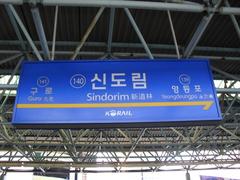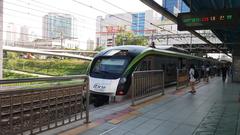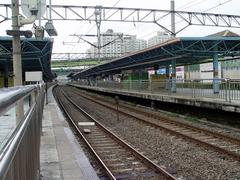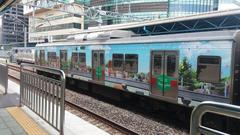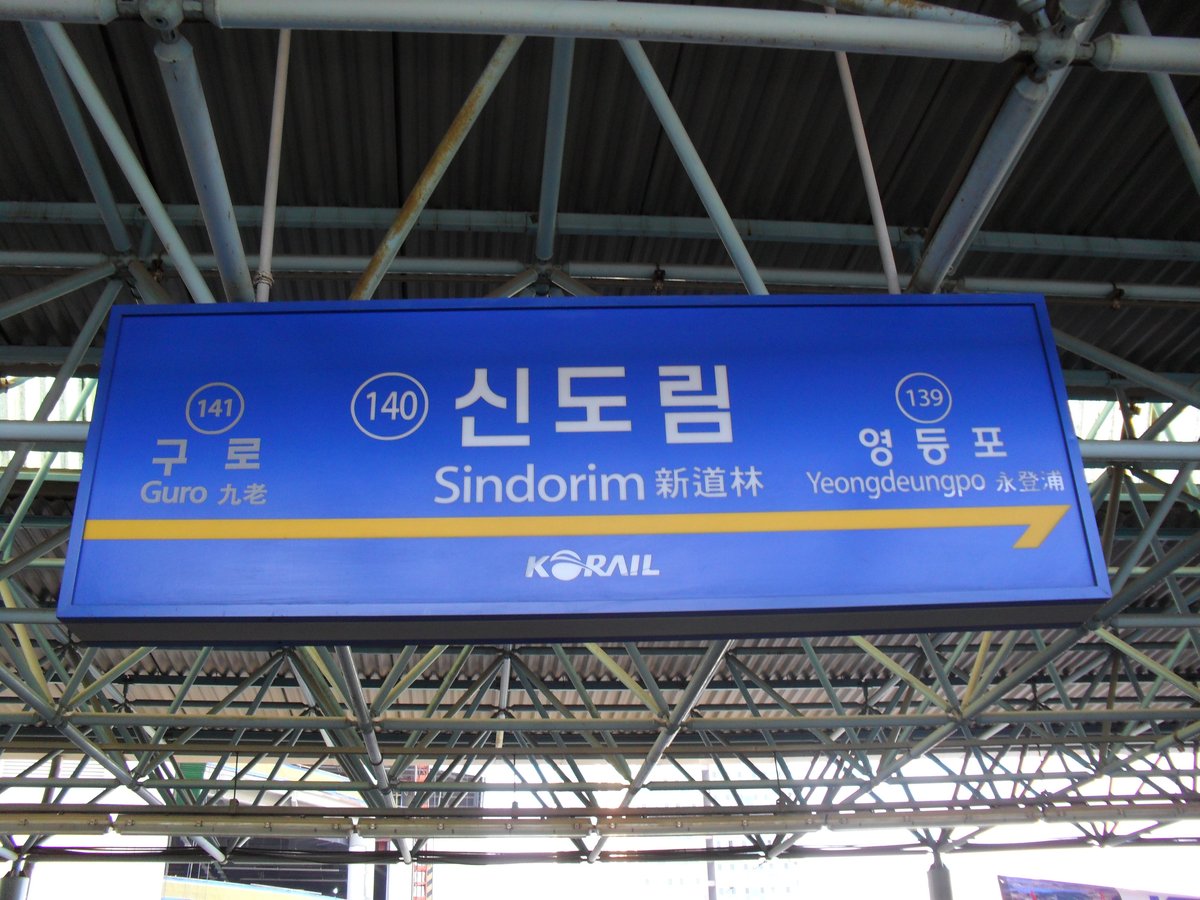
Sindorim Station Visiting Hours, Tickets, and Seoul Historical Sites Guide
Date: 14/06/2025
Introduction to Sindorim Station and Its Significance in Seoul
Sindorim Station (신도림역) is one of Seoul’s most important transit nodes, serving as a bustling interchange between Line 1 and Line 2 since 1984. Strategically located in the northern part of Sindorim-dong, Guro-gu, the station connects residential, commercial, and industrial areas, accommodating over 320,000 daily passengers (Wikipedia). Sindorim Station reflects Seoul’s urban expansion and ongoing modernization, with renovations over the years introducing features such as platform screen doors, elevators, and underground shopping arcades (Kojects).
For visitors, Sindorim Station is more than a transit hub—it provides direct access to major shopping and entertainment complexes like D-Cube City, Emart, and Technomart. Its proximity to venues such as the D-Cube Arts Center and Gocheok Sky Dome also cements its place as a vibrant urban landmark (Korea Travel Planning). The station features comprehensive accessibility options, ensuring a comfortable experience for all, including those with mobility needs (Seoul Danurim).
Looking ahead, the addition of the high-speed GTX B Line will further enhance Sindorim’s role in Seoul’s transportation network, promising reduced travel times and expanded regional connectivity (Wikipedia: Great Train eXpress).
This guide offers detailed information about Sindorim Station’s history, facilities, accessibility, nearby attractions, and future developments, ensuring a seamless experience whether you are commuting, sightseeing, or exploring Seoul’s vibrant cityscape (Kojects, Seoul Danurim).
Table of Contents
- Introduction
- Historical Background and Significance
- Practical Visitor Information
- Nearby Attractions and Amenities
- Cultural and Social Highlights
- Operational Overview and Challenges
- Future Developments at Sindorim Station
- FAQs
- Summary Table: Sindorim Station at a Glance
- Plan Your Visit
- Visuals and Media Recommendations
- Stay Connected
Historical Background and Significance
Origins and Early Development
Sindorim Station opened in 1984 as part of Seoul’s rapid transit expansion, initially serving Line 2 (Wikipedia). Its strategic position at the edge of Sindorim-dong in Guro-gu enabled it to connect various zones across the city (Wikipedia). The subsequent addition of Line 1, which links to the Gyeongbu rail corridor, elevated Sindorim’s importance, enabling easy transfers between Seoul and surrounding cities such as Incheon and Suwon (Korea Travel Planning).
Expansion and Modernization
With Seoul’s growth, Sindorim Station underwent significant upgrades in the 2010s, including the installation of an overhead walkway, expanded platforms, safety screen doors, and improved accessibility (Kojects). The station’s renovations have transformed it into a modern, integrated transit hub with extensive shopping and dining options.
Practical Visitor Information
Visiting Hours and Ticketing
- Operating Hours: Approximately 5:30 AM to midnight, in line with Seoul Metro’s general schedule.
- Ticketing: Tickets are available at automated kiosks and staffed counters. The T-money card, a rechargeable transit card, is widely used for seamless travel across buses and subways. Basic fares start at around 1,350 KRW.
Accessibility
Sindorim Station is equipped with elevators, escalators, tactile paving, and accessible restrooms to accommodate passengers with different mobility needs (Seoul Danurim).
Travel Tips
- Avoid peak hours (7–9 AM, 6–8 PM) to minimize congestion.
- Use online or on-site station maps for efficient navigation.
- Follow bilingual signage for line transfers.
Nearby Attractions and Amenities
Shopping and Entertainment
Sindorim Station connects directly to D-Cube City, Emart, and Technomart, offering shopping, dining, cinemas, and cultural events. D-Cube Arts Center, within D-Cube City, hosts concerts and musicals.
Hotels and Accommodation
There are several hotels and guesthouses nearby, including the Ramada by Wyndham Seoul Sindorim, ideal for both business and leisure travelers (Visit Korea).
Photographic Spots and Guided Tours
Sindorim’s modern design and busy atmosphere provide unique urban photography opportunities. While there are no dedicated station tours, exploring Guro District reveals the area’s transformation from an industrial zone to a commercial hub.
Cultural and Social Highlights
Sindorim Station features in Korean pop culture and hosts public performances, reinforcing its role as a community gathering point (Kojects). The station captures authentic scenes of daily life in Seoul.
Operational Overview and Challenges
Handling over 320,000 daily passengers, Sindorim is among Seoul’s busiest stations (Wikipedia). Despite modernizations, peak-hour congestion remains a challenge, with ongoing efforts to improve passenger flow and comfort.
Frequently Asked Questions (FAQ)
Q: What are Sindorim Station’s operating hours?
A: About 5:30 AM to midnight, daily.
Q: How can I buy tickets?
A: Use automated kiosks or staffed counters; T-money cards are preferred for convenience.
Q: Is the station accessible for people with disabilities?
A: Yes, with elevators, escalators, tactile paving, and accessible restrooms.
Q: What attractions are nearby?
A: D-Cube City, Technomart, and D-Cube Arts Center.
Q: How crowded does it get?
A: Peak hours are especially busy; off-peak travel is recommended for comfort.
Summary Table: Sindorim Station at a Glance
| Aspect | Details |
|---|---|
| Opening Year | 1984 |
| Subway Lines | Line 1 (overground), Line 2 (underground) |
| Daily Passengers | Over 320,000 |
| Amenities | Elevators, escalators, ticket kiosks, shops, accessible restrooms |
| Nearby Facilities | D-Cube City, Emart, Technomart, hotels |
| Cultural Notes | Featured in music and public performances |
| Planned Upgrades | Platform extensions, new transfer facilities |
Plan Your Visit
Sindorim Station is both a vital transit interchange and a destination in its own right. Whether you’re transferring between subway lines or exploring nearby commercial centers, plan your route using official Seoul Metro resources for a smooth experience.
Visuals and Media Recommendations
- View images and station maps via Seoul Metro’s official website.
- Try virtual tours or video walkthroughs to familiarize yourself with transfer pathways before arrival.
Stay Connected
Follow official transit social media channels for the latest updates, and download transit apps for real-time schedules and navigation tips.
For comprehensive information, visit Sindorim Station on Wikipedia, Kojects, and Korea Travel Planning.
Station Layout and Facilities
Sindorim Station is a multi-level complex with Line 1 platforms below and Line 2 platforms above. Wide concourses, multiple exits, and bilingual signage ensure smooth navigation. Notably, Exit 1 leads directly to Hyundai D-Cube City (Visit Korea). Underground shopping arcades and pedestrian walkways provide weather-protected access.
Facilities
- Ticketing: Multiple vending machines and fare adjustment counters supporting T-money cards (Sunsets Abroad).
- Restrooms: Clean, accessible, and equipped for those with disabilities (Seoul Danurim).
- Retail: Convenience stores, bakeries, vending machines.
- Customer Service: Multilingual information desks.
- Platform Screen Doors: Safety and climate control on all platforms.
- Waiting Areas: Platform seating (limited during busy times).
- Digital Displays: Real-time information in Korean and English.
- Wi-Fi and Charging: Free Wi-Fi and charging stations in select areas.
Congestion Patterns
Sindorim Station is busiest during weekday rush hours (7–9 AM and 6–8 PM), especially on Fridays and in May (Seoul Metro Report). The transfer corridor between Lines 1 and 2 is a known bottleneck (Korea JoongAng Daily). Event venues like D-Cube Arts Center and Gocheok Sky Dome can cause temporary surges (Visit Korea). Off-peak hours (midday, late evenings) are more comfortable.
Accessibility
Sindorim Station is equipped to serve passengers with diverse needs:
- Elevators and Ramps: Connect all levels (Seoul Danurim).
- Wheelchair Access: Accessible gates, tactile paving, platform gap reduction.
- Audio-Visual Aids: Announcements and digital displays in Korean and English; braille tiles for navigation.
- Accessible Restrooms: Clearly marked and equipped with emergency features.
- Priority Seating: For elderly, pregnant, and disabled passengers.
- Nearby Accessible Hotels: Ramada by Wyndham Seoul Sindorim (Seoul Danurim Hotel Info).
- Taxi/Airport Services: Wheelchair-accessible taxis available (Seoul Danurim).
Visitor Tips for Navigating Sindorim Station
- Allocate extra transfer time during peak hours.
- Plan elevator usage for luggage or mobility aids.
- Use a T-money card (Sunsets Abroad).
- Follow bilingual signage and digital displays.
- Travel off-peak for comfort.
- Monitor announcements for service updates.
Frequently Asked Questions (FAQ)
Q: What are Sindorim Station’s operating hours?
A: Typically 5:30 AM–midnight.
Q: Is the station wheelchair accessible?
A: Yes, with elevators, ramps, tactile paving, accessible restrooms, and priority seating.
Q: How do I buy tickets?
A: Use vending machines or counters; T-money cards are recommended.
Q: Are there charging facilities for phones?
A: Yes, in select areas.
Q: How crowded is Sindorim Station?
A: Very busy during rush hours; less crowded midday and late evening.
Future Developments: The GTX B Line
Project Overview
The GTX (Great Train eXpress) B Line is a high-speed commuter rail line that will connect Songdo (Incheon) to Cheongnyangni (northeastern Seoul), with Sindorim as a key station (Wikipedia: Great Train eXpress). Construction started in 2024, with expected completion by 2030 (Kojects: GTX Seoul Start Construction).
Projected Impact and Upgrades
- Travel Speeds: Up to 180 km/h, reducing travel times dramatically.
- Transfer Efficiency: Sindorim will serve as an interchange between local subway and GTX lines.
- Upgrades: Expanded concourses, enhanced signage, more elevators/escalators, and improved security.
Visitor and Travel Tips
- Expect occasional detours and increased congestion during construction.
- After completion, enjoy faster cross-city travel and integrated ticketing.
- GTX B Line tickets will be available through current transit card systems.
- Sindorim’s operating hours will remain roughly 5:30 AM–midnight.
Attractions Near Sindorim Station
D-Cube City
A multi-purpose complex directly connected to Sindorim Station, D-Cube City offers shopping, dining, and entertainment, open from 10:30 AM–10:00 PM. The D-Cube Arts Center hosts concerts and musicals, while the plaza regularly features seasonal festivals, such as the St. Patrick’s Day celebration (Korea Herald).
Yeongdeungpo and Guro Districts
Times Square Mall (Yeongdeungpo) and the Guro Digital Complex are nearby, providing shopping, dining, and technology-related experiences.
Parks
Yeouido Hangang Park, accessible by Line 2, offers riverside recreation and is especially beautiful during cherry blossom season.
Sindorim Station Amenities and Visitor Information
- Restrooms: Clean and accessible.
- Lockers: Coin-operated for luggage and shopping.
- Information Desks: Korean and basic English support.
- Accessibility: Elevators, ramps, tactile paving.
- Wi-Fi & Charging: Free public Wi-Fi and charging stations.
Food and Shopping
Numerous cafes, fast-food outlets, food courts, and convenience stores are located within the station and D-Cube City.
Cultural Insights
Sindorim Station is a symbol of Seoul’s modernity and multicultural spirit, regularly hosting international events and performances in D-Cube City Plaza (Korea Herald). The vibrant mix of local eateries and modern shopping reflects the city’s evolution.
Practical Tips
- Use Exit 1 for direct access to D-Cube City.
- Avoid rush hours for comfort.
- Consider the Climate Card Tourist Pass for unlimited transit (In My Korea).
- For airport access, use Line 2 to reach Hongdae or Seoul Station.
- Queue politely and use translation apps for smooth interactions (Hey Roseanne).
- Report lost items at information desks or online.
- Use Naver Map or KakaoMap for navigation (In My Korea).
Frequently Asked Questions (FAQ)
Q: What are Sindorim Station’s hours?
A: 5:30 AM–midnight.
Q: Are lockers available?
A: Yes, coin-operated lockers are on site.
Q: How do I transfer lines?
A: Follow bilingual signage; allow extra time.
Q: Is the station accessible?
A: Yes, with elevators, ramps, and tactile paving.
Q: Are there special events at Sindorim?
A: D-Cube City Plaza regularly hosts festivals and performances.
Q: How to get to the airport?
A: Take Line 2 to Hongdae or Seoul Station for airport trains.
Call to Action
Start your Seoul journey at Sindorim Station—explore shopping, cuisine, and culture in one of the city’s most dynamic neighborhoods. For real-time updates, download the Audiala app and follow our social media channels.
Summary and Key Visitor Tips
Sindorim Station exemplifies Seoul’s commitment to efficient transit and vibrant urban life. As it continues to evolve—especially with the GTX B Line—Sindorim remains a nexus of convenience, connectivity, and cultural energy. Leverage station amenities, plan transfers during off-peak hours, and explore the surrounding attractions for a rewarding Seoul experience (Kojects, Seoul Danurim, Wikipedia: Great Train eXpress, Korea Travel Planning).
References
- Sindorim Station - Wikipedia
- Sindorim-dong - Wikipedia
- Korea Travel Planning: Seoul Subway Map
- Kojects: Sindorim Installs New Walkway, Shifts Platforms
- Seoul Danurim Accessible Tourism Center
- Visit Korea: Ramada by Wyndham Seoul Sindorim
- Sunsets Abroad: Seoul Travel Guide for First-Time Visitors
- Korea JoongAng Daily: Korean Subways and Public Transportation
- Wikipedia: Great Train eXpress
- Kojects: GTX Seoul Start Construction
- Korea Herald: St. Patrick’s Day Festival in Seoul
- Namu Wiki: Seoul Bus 6649
- In My Korea: South Korea Travel Guide and Korean Travel Tips
- Hey Roseanne: Seoul Travel Guide
